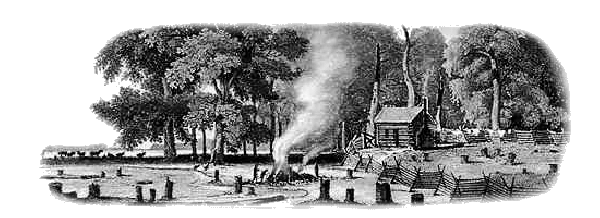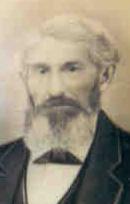
This document was transcribed from a letter written by Sylvester W. Evans (sometimes spelled Evens, as in this letter) and details the arrival of his father, John P Evans, in Annin Creek, McKean County, PA. The text was transcribed verbatim, including errors in spelling and grammar. Sylvester probably didn't get much formal education and his spelling is often phonetic, which we suspect is why our name is now Evens instead of Evans - Jackie (Evens) Allen
A sketch of the early days of Annin Creek which was first settled by the Rev. J.P. Evens who was a resident of West Almond, Allegany County, New York. In the year 1836 in company with friends living on Bells Run Mr. Evans was hunting for stray cattle and got over the mountain into the valley of Annin Creek, then a dense wilderness. While there Mr. Evens took the ax from Benjmin Vandermark and marked a a large hemlock tree that when felled was a little over 5 ft across. "The stump", Mr. Evens remarked to Vandermark that, ",that would be about the middle of his farm".
Said tree was then standing near a little stream that comes down from the North a little East of the Orchard on the farms now owned by F K Windship. Mr. Evens accordingly went to the Land Agent the next day and bought 100 acres at $1.50 per acre.
That same fall, Mr. Evens with his two sons, John P. Jr. and James C. Evens came out from West Almond and built a log house leaving the writer of this sketch, Sylvester W. Evens, then 12 years old, to dig the Potatoes and fatten the hogs.
Mr. Evens and his sons built a shanty of hemlock brush by the side of the big hemlock tree to live in while they built the log house. Mr. Evens then brought his family and goods to Richburg so the children could go to school until February 1837 when he again broke camp and mooved in to the log house in the forest 3 miles from any inhabitants.
The floors of the house was made of planks split out of basswood trees and hewed with an ax the roof of shingles 3 feet long and not sawed. The space between the logs was chinked with pieces of timber split out of logs and fastened in the cracks. No stove or fire place except a space left without floor in one end of the house on which a fire was built.
The family started from Richburg in the morning with a hors (horse) .) team and reached the log house before dark. The oldest son, J.P. and S.W., the writer of this sketch, also started in the morning each with a pair of oxen and a load of goods on old fashioned sleds, arriving after dark at Wilord Taylors who then lived on the farm later known as the Grove Farm now owned I think by a man by the name of Black.
It being so very dark, we stoped at Taylors and visited until the moon came up, then commenced the journeyed over the mountain to the log house in the woods ariving there about midnight.
The next day all the children who was able to wallow through the snow was out gathering moss of the trees to cork the cracks in the house while the men was building a shelter for the cattle which was made of hemlock boughs. That done, they commenced the choping.) and getting the land ready for crops and before it was to late to put in spring or summer crops. We had cleared and got in twelve acres, of corse some of them was late but we got quite good returns.
Game was plenty, the deer frequently came around in sight of the house and one day in the winter of 1837-38 a large wolf pased thru the doar yard while the family was eating dinner.
The family consisted of Father, Mother, four boys and three girls. We had good health and was happy as larks.
In the fall of 1837 Deacon Samuel Cooper with his Wife and two sons Theron and Silas came in a settled on the farm. Where Theron now lives I think Theron or the boys together managed the farm whil he Father done blacksmithing. That same winter, Joseph Hodges moved in, then Jai Elliot and others.
Then came the necesity of a school house which was built of logs on the ground very near if not exactly where the Baptist Church now stands. The Settlers being nearly all Baptist, a Baptist Church was organized in 1838 of members living in Annin Creek and at Ceres and to the name of the First Baptist Church of Annin Creek. I think Father Evens preached to the Annin Creek Church about until the fall of that year or until the fall of 1840 and which time he engaged to preach at the Norwich and Smethport Church as an assistant. Elder Sawyer being settled as their as Pastor and there being to mutch work for one man. The two churches being one at that time and bearing the name of the Norwich and Smethport Church .
Mr. Evens returned to his farm on Annin Creek in the fall of 1841 and the next year was employed by the missionary board of Philidlphia to travel as a missionary in the McKean and Potter Countys and I think he traveled about 3000 miles on hors back in in the corse of that year. And during his labor as a preacher of the Gospel he Baptised six of his Children. One the the Genesee River, and five in Annin Creek and of the the six became members of the Annin Creek Church. - Sylvester W Evens

Sylvester W. Evens
1824-1905
Related Links
Ceres PA/NY Names Dates and Places
Newspaper Article about Ceres People
Blanch Holmes and Portville School #6
Census Norwich, McKean Co. Pa [1840 ] [1850 ] [1860 ]
Write to me binkie@rochester.rr.com